#composting in Belize
Explore tagged Tumblr posts
Text
Dandelion News - March 8-14
Like these weekly compilations? Tip me at $kaybarr1735 or check out my Dandelion Doodles!
1. Caribbean reef sharks rebound in Belize with shark fishers’ help

“Caribbean reef shark populations have rebounded beyond previous levels, more than tripling at both Turneffe and Lighthouse atolls[…. The recovery] arose from a remarkable synergy among shark fishers, marine scientists and management authorities[….]”
2. Landmark Ruling on Uncontacted Indigenous Peoples’ Rights Strikes at Oil Industry

“[T]he Ecuadorian government [must] ensure any future expansion or renewal of oil operations does not impact Indigenous peoples living in voluntary isolation. [… E]ffective measures must be adopted to prevent serious or irreversible damage, which in this case would be the contact of these isolated populations,” said the opinion[….]”
3. America's clean-energy industry is growing despite Trump's attacks. At least for now

“The buildout of big solar and battery plants is expected to hit an all-time high in 2025, accounting for 81% of new power generation[….] The industry overall has boomed thanks to falling technology costs, federal tax incentives and state renewable-energy mandates.”
4. Study says endangered Asian elephant population in Cambodia is more robust than previously thought
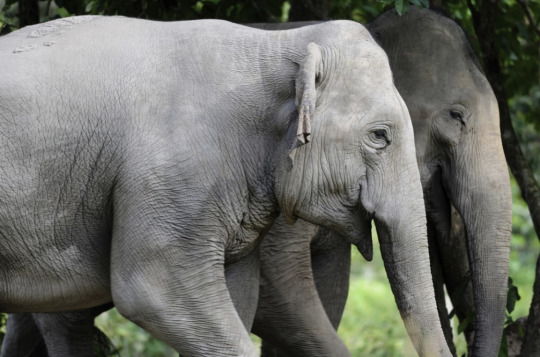
“A genetic study of Asian elephants […] reveals a larger and more robust population than previously thought, raising hopes the endangered species could slowly recover. […] “With sufficient suitable habitat remaining in the region, the population has the potential to grow if properly protected,” the report concludes.”
5. Scientists are engineering a sense of touch for people who are paralyzed

“[Engineers are] testing a system that can restore both movement and sensation in a paralyzed hand. [… A]fter more than a year of therapy and spinal stimulation, [… h]is increased strength and mobility allow him to do things like pet his dog. And when he does, he says, "I can feel a little bit of the fur."“
6. Florida is now a solar superpower. Here’s how it happened.

“In a first, Florida vaulted past California last year in terms of new utility-scale solar capacity plugged into its grid. It built 3 gigawatts of large-scale solar in 2024, making it second only to Texas. And in the residential solar sector, Florida continued its longtime leadership streak.”
7. Rare frog rediscovered after 130 years
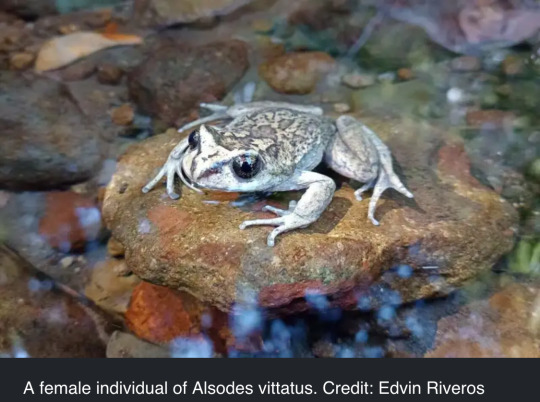
“The researchers discovered two populations of the frog[….] "The rediscovery of A. vittatus allowed us to obtain, more than a century after its description, the first biological and ecological data on the species.” [… S]hedding light on where and how they live is the first step in protecting them.”
8. Community composting programs show promise in reducing household food waste
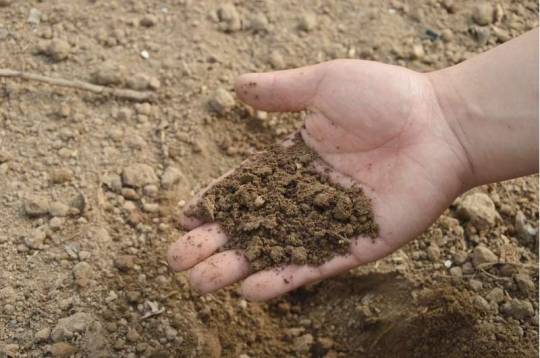
“The program [increased awareness and reduced household waste, and] also addressed common barriers to home composting, including pest concerns and technical challenges that had previously discouraged participants from composting independently.”
9. Pioneering Australian company marks new milestone on “mission” to upcycle end-of-life solar panels
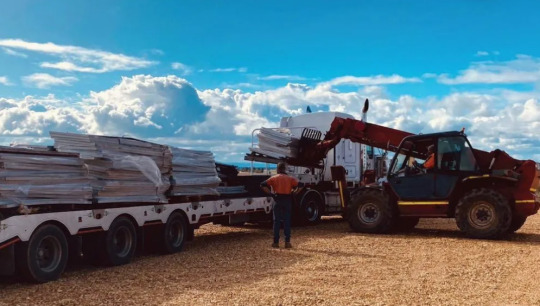
“[…] SolarCrete – a pre-mixed concrete made using glass recovered from used solar panels – will form part of the feasibility study[….] A second stage would then focus on the extraction of high value materials[…] for re-use in PV and battery grade silicon, [… and] electrical appliances[….]”
10. Beavers Just Saved The Czech Government Big Bucks
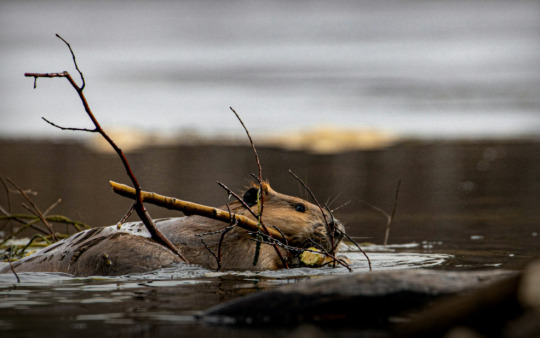
“The aim was to build a dam to prevent sediment and acidic water from two nearby ponds from spilling over, but the project was delayed for years due to negotiations over land use[….] Not only did the industrious rodents complete the work faster than the humans had intended, they also doubled the size of the wetland area that was initially planned.”
March 1-7 news here | (all credit for images and written material can be found at the source linked; I don’t claim credit for anything but curating.)
#hopepunk#good news#shark#fishing#nature#ecuador#first nations#oil drilling#clean energy#solar energy#solar power#elephants#elephant#conservation#animals#science#medicine#paralyzed#florida#solar panels#frogs#endangered species#endangered#compost#community#australia#recycling#beaver#habitat restoration#beaver dam
148 notes
·
View notes
Text
“Big Log” in San Pedro, Ambergris Caye, Belize.
“Big Log” in San Pedro, Ambergris Caye, Belize.
Knowing that windows for the greenhouse were about to be fitted I woke up slightly before 04.00 hours, made my mug of black, unsweetened instant coffee and read what Mikel Arteta, he’s Manager of Arsenal had to say the previous day at a press conference. With the season my team is having I was looking for any good news ! I didn’t really get any, it was more of an injuries update. Oh well, at…

View On WordPress
#abelizehomeforus#Ambergris Caye#Ambergris Caye blog#Belize#Belize blog#Bokashi#Building a cement home in Belize#building a concrete home in Belize#building a concrete home on Ambergris Caye#building in Belize#composting in Belize#Effective microorganisms#Estel&039;s Dine By the Sea#expats#expats in Belize#expats in San Pedro#expats on Ambergris Caye#gardening in Belize#gardening on Ambergris Caye#John East#life in Belize#Living in Belize#organic gardening in Belize#organic gardening on Ambergris Caye#organic vegetable gardening in Belize#organic vegetable gardening on Ambergris Caye#Qualified Retirement Programme#Robert Plant#San Pedro#San Pedro blog
1 note
·
View note
Text
Blog #3
Vanilla in the Mayan World
By Anthony Orlando

Likely first cultivated by the neighboring Totonac people, the Mayans would use the world’s only edible orchid to flavor their more well-known cocoa drinks (Delsol). Vanilla, along with cocoa and annatto, would in many ways serve as a stabilizing force in the economy of later Mayan states (Marty), particularly Itza until their decline in 1697.
Itza’s farming of vanilla and cocoa during the periods of conflict brought to the region by the Spanish only produced of the resource for its small elite class due to the difficulty in growing the plants in their homeland of central Peten (Marty). Itza would be able to grow in power by seizing more usable land for vanilla growth from neighboring states, giving itself a solid regional and economic base by doing so, while also using their newfound power to subjugate the Manche C’hol Mayans and force them to further trade their vanilla commodities with them (Marty). Spaniards and Portuguese would begin bringing it back to the old world in the 16th century, when they would give vanilla its now used name, meaning “little pod” (Delsol).
Delsol, Christine. “10 Maya Foods That Changed the World's Eating Habits.” SFGate, Hearst Communications, 26 Aug. 2009, www.sfgate.com/mexico/mexicomix/article/10-Maya-foods-that-changed-the-world-s-eating-2477935.php.
Marty. “The History of Vanilla in Ancient Maya Culture.” Ambergris Caye Belize Message Board, Casado Internet Group, 24 Feb. 2017, ambergriscaye.com/forum/ubbthreads.php/topics/521935.html.
How Climate Change Affects Mayan Farmers Today
By Courtney King
Today, Mayans are still alive and practicing their farming ways - the same way they have been doing it since the beginning. A farmer from the Yucatan Peninsula, Dionisio Yam Moo, is a Mayan who still practices a farming technique called milpa. Milpa farming is dependent on rain and is when farmers cut down trees and burn the forest, plant crops, and then let the rest of the burnt and bare land regenerate for up to 30 years. Milpa farming allows the farmers in the Yucatan Peninsula to grow wonderful crops, despite having thin soil with a lack of nutrients. With this technique, vegetables like corn, squash, beans, etc. are able to be grown. But in recent years due to climate change, there has been a lack of rainfall in this area. This is bad for farmers like Yam Moo who uses the milpa technique because it is very dependent on rainfall. He would plant his crops, and then for months there would be no rain until it would pour and then flood the field. This ultimately damaged his crops.
In order to fight the climate change, Yam Moo, along with other mayan farmers, have improved the milpa technique. They do not cut down parts of the forest anymore but they still grow many different crops per usual. And because of the unpredictable rain, they have installed an irrigation system which comes from an above the ground rainwater collector. Yam Moo has also found that tilling the soil with compost keeps it healthy and full of nutrients - so cutting down trees for new land won’t be necessary. Milpa has been around for many many centuries and is still used today, only with improvements because of the new climate Mayan farmers are faced with. They are always improving their methods and still producing crops!
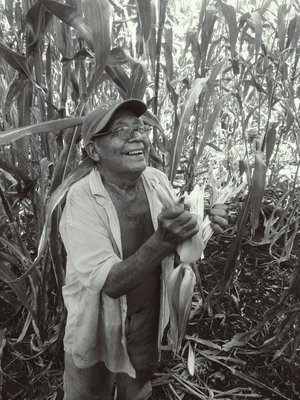
Popkin, Gabriel. “Mayans Have Farmed The Same Way For Millennia. Climate Change Means They Can't.” NPR, NPR, 3 Feb. 2017, www.npr.org/sections/thesalt/2017/02/03/510272265/mayans-have-farmed-the-same-way-for-millennia-climate-change-means-they-cant.
Article 8: Native Tobacco (continued)
By Alex Powers
Tobacco use amongst the Mayan civilization itself, is represented today in what remains of their artwork, literature, and architecture. While the language of the Mayan people remains untranslatable, the art work that adorns the walls of ruins, as well as the statues and monuments surrounding these ruins, paint a vivid picture of Mayan culture utilizing tobacco ritualistically, medicinally, and socially. Cultural differences between the Aztecs and the Mayans were referenced as having a relationship similar to that of modern America and the Romans. The Mayan, Aztec relationship was closer in similarity to the Romans and the Greeks, in that the Mayans were the Greeks and the Aztecs were the Romans. Just as the Greeks did, the Mayans constructed monuments to their gods, many of whom were offered tobacco as homage.
First cultivated in agricultural plots surrounding population densities, harvested, dried, then sold, or distributed, tobacco was a crop that provided no sustenance but was highly desirable. The Mayan use of tobacco as hygienic meant using the smoke to “clean” their teeth, Mayans envisioned the cigar as we the toothbrush. Tobacco smoke played a more significant role in Mayan culture than the tobacco leaf itself. In religious ceremonies, utilizing natural tobacco smoke created hallucinating effects, which accompanied medicine men and shamans as visual aids. In these same religious ceremonies, the smoke rising would represent the ascension of ancestors. While implemented in various facets of their society, true knowledge of Mayan tobacco use remains subjective as much of their history with the plant is quite skeptical. Essentially, what we’ve observed about Mayan tobacco use, was observed with the interactions of later cultures and the Spanish explorers. The importance of visual imagery in scholarship surrounding Mayan tobacco use is vital, as much of the Mayan documentation on their use is untranslatable.
Benjamin, Thomas. The Atlantic World in the Age of Empire. Boston: Houghton Mifflin Company, 2001.
Foster, Lynne V. Handbook to Life in the Ancient Maya World. Oxford: Oxford University Press, 2002.
Gately, Iain. Tobacco: A Cultural History of How an Exotic Plant Seduced Civilization. New York: Grove Press, 2001.
Thornton, John K. A Cultural History of the Atlantic World. New York: Cambridge University Press, 2012.
Robicsek, Francis. Smoking Gods: Tobacco in Maya Art, History, and Religion. Norman: University of Oklahoma Press, 1978.
Rushforth, Brett. Colonial North America and the Atlantic World: A History of Documents. New York: Routeledge, 2008.
The Mayans and the beginning of Chocolate
By Martha Rivera
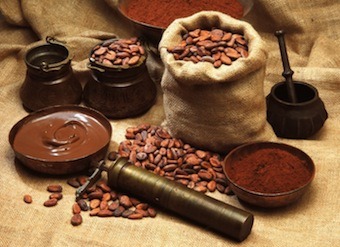
It is said that Cocoa beans were first discovered by the Mayan people as early as 600 A.D. The Mayans harvested cocoa beans and because they loved chocolate so much, they eventually cleared much of their lands so that they were able to grow their own cocoa trees and start a plantation harvesting cocoa, as well as their original crops. The word chocolate is said to come from the Mayan word xocolatl, which means bitter water. Chocolate was a liquid made from crushed cocoa beans, chili peppers, and water. They learned that the beans inside the cocoa pods could be made by first harvesting the seeds, drying them, roasting them, removing their shells, and then ground them into paste. Most of the same process has not been changed and still used today, especially by living Mayans who still live by their traditional ways of the past. Mayans called cacao, chocolate “food for the gods” and was a treasured Mayan treat, as well as, still is today. Chocolate, then, was associated with people of high status and drank/ate during special occasions such as; religious ceremonies, parties and marriage celebrations. Mayan artifacts have been found to show Kings of the Mayan gods drinking chocolate.
Cacao became so popular, that even Mayan groups living in other areas, such as the Yucatán, where the climate wouldn't support a tropical rainforest, apparently found ways to grow some cacao trees in their fields. The Mayan people also had many trade networks that helped ensure steady supplies of cacao throughout Mesoamerica, even in areas too cool or dry for cacao trees to flourish.
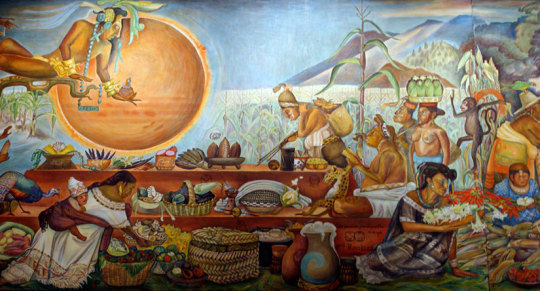
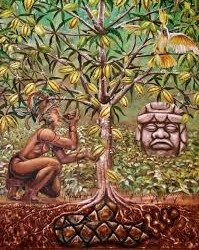
“Cacao: The Mayan.” Ricochet Science, 14 Apr. 2016, ricochetscience.com/cacao-mayan-food-gods/.
“The History of Chocolate.” Chocolate and the Mayans - Chocolate and the Mayans | HowStuffWorks, HowStuffWorks, 18 Nov. 2007, www.howstuffworks.com/history-of-chocolate1.htm.
Cacao in Ancient Maya Religion, www.mexicolore.co.uk/maya/chocolate/cacao-in-ancient-maya-religion.
The Maize God
By Courtney King
As you can tell from reading our entries on this blog, agriculture was a major part of the Mayans way of life. Out of all the crops that the Mayans grew, the most important would be the staple crop, corn. Corn or maize was very important to the Mayans because it was easy to grow in their climate, easy to store, and could be served in many different forms and also used for things such as baskets or even fuel - not just solely for being consumed. Because of the importance of corn in the Mayan way of life - there was a God dedicated to this crop. The Maize God, Hun Hunahpu, is depicted as a young man with corn on his headdress and his hair made out of silk from corn. The Maize God was thought to be beheaded at the start of the harvesting season and then reborn once when the new growing season began. Because of this, the Maize God was also looked at as “the cycle of rebirth” and “associated with the growth of crops” - which made this God that much more important. When the Mayans experienced long periods of drought, “...they would turn to the Gods responsible for food, rain and fertility.” (The British Museum). Praying to the Gods gave the Mayans a sense of hope that their crops would be okay and would still prosper. Sometimes, they even had rituals for the Gods that sometimes included sacrificing your own blood or something less serious like singing and dancing. I think it is really cool and interesting how they had so many Gods for various things - even down to corn!
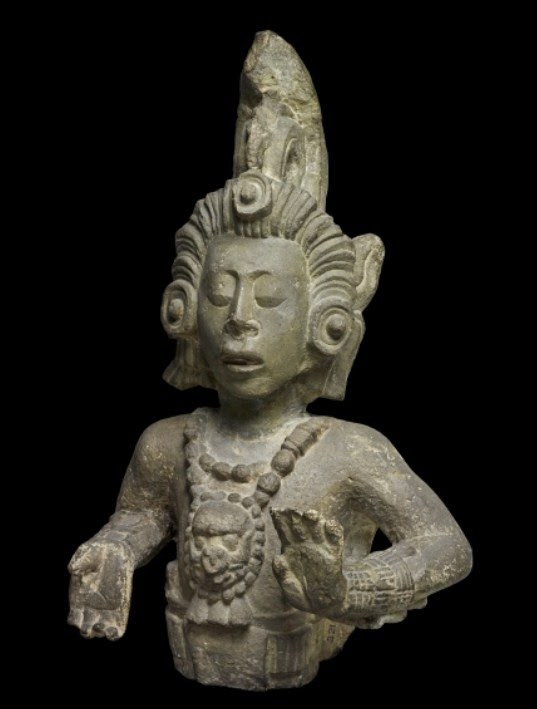
Works Cited: “Teaching History with 100 Objects.” Teaching History with 100 Objects - The Maya Maize God, The British Museum , www.teachinghistory100.org/objects/about_the_object/maize_god.
1 note
·
View note
Text
A Case of the Bacalar Blues
The stars seemed to align to bring me to a town in southeastern Mexico near the Belize border called Bacalar. Prior to my arrival, I met a woman from Peru, also staying at my Airbnb in Tulum, who had just spent eight nights in this mysterious Bacalar and said that I absolutely had to go. I hadn’t even heard of Bacalar before, but should I be surprised? As embarrassing as this is to admit, I’d done little research prior to my travels in the last year (with the exception of India, that was my baby - I pretty much slept with the lonely planet book and had 7-10 various India related web browsers going at all times for about a month before I left!)
But back to Mexico and winging it; I loved getting first hand recommendations. So I did some googling; the pictures were stunning, people were saying it was the Tulum of 30 years ago, and it was slow and quiet, I was more than sold.
I felt an immediate sense of comfort when I eventually arrived in Bacalar. I found my Airbnb, which was a small cute little house surrounded by bushes and coconut trees just a 5 minute stroll from the water, and met the lovely Laura who welcomed me ever so warmly into her home.
As I walked into town that first day to scope out avocados (obviously), I felt an overwhelming sense of content and lightness that I hadn’t felt since India. It felt like a mix of the peaceful remote quiet of Munroe Island in Kerela, and the small town flutter of Pondicherry.
If you google Bacalar you will see that it’s on Lake Bacalar, also called the Lagoon (Laguna in Spanish) of Seven Colors, and you will also likely find it referred to as ‘magical’. I’ve since heard this description being used in many contexts as it relates to Bacalar, but for me it’s become a place of the ‘magical healing waters’. The tour guides on my sunrise-stand-up-paddle-board tour took some time to explain to the group the history and importance of the laguna in which they’d made the decision to call home.
The laguna was first home to thousand year old photosynthesizing microbes layered to form Stromatolites. Stromatolites in fossil form are recorded as ancient life on Earth. They can be found in hypersaline lakes like in Western Australia, or in freshwater lagoons like Bacalar, to name just a couple. The mineral content is so high that it makes it almost impossible for most wildlife to survive, which protects the Stromatolites from being destroyed and allows them to continue to release an abundance of oxygen into the water.
I’d had three days swimming in the ‘magical healing waters’, and I started seeing an incredible improvement in my Psoriasis, which had been starting to flare up over the last few months.
Needless to say I tried to spend as much time as I could in the water, and would literally be in the lagoon until after sunset some days, watching the sky change color and trying to soak up all the minerals I could. Growing up (and still to this day) my Mom had always said I was like a fish in water. I excelled at swim lessons, loved spending summers on the lakes, and I still love being by and in the water.
With the laguna being fresh water it was easy on the eyes to be under water and I spent so much time completely submerged. I wound’t be surprised, with the amount that went into my ears and nose, if my water content was now half laguna agua!
The water was shallow enough to stand, and I found myself diving down over and over and instinctively practicing my mermaid tail kicks..for real. I was having flash backs of the Little Mermaid movie adaptation recently released on Netflix that I had just watched, and was out there so long without a soul around I think I actually thought I WAS a mermaid. Or maybe I was subconsciously tapping into dreams I might have had the previous night after smoking the dream herb (calea zacatechichi) with my host Laura.
Wait, pause, what?
Yeah I know, I was just as surprised when this sweet, gorgeous, life coach, nature loving, composting, Mexican mother of an 18 year old asked me after dinner one night if I wanted to smoke or drink the herb with her. After getting over my surprise, I googled it for awhile before agreeing - feeling like there was no way this beautiful hippie who had lived with the indigenous people in the Mexican mountains could lead my astray.
We had become quite close considering I had just been there a couple days, and I felt like I could trust her. When she lived in the mountains they used nothing but plants for food, nutrition and medicine, and this was when she was exposed to the dream herb. So we rolled some herb and sat in the dark in the garden under the stars smoking a very very bitter tasting plant.
Anxieties relieved, I felt nothing but slightly tired, and packed it in for an early (as usual) night. Many people use the dream herb to get answers to questions they find themselves plagued with, so I was hopeful yet trying not to put too much pressure on this one smoke to reveal to me the meaning of life, or anything quite that substantial. I didn’t end up having any lucid dreams but I thought maybe that’s where part of my mermaid manifestation could have come from, in combination with the movie.
There’s a funny meme out there with a photo of a mermaid with the text saying:
‘If your thighs are touching then you’re one step closer to being a mermaid, so who’s the real winner here’
It’s always spoken to me!
So there I was, half lagoon water, half mermaid. Moving on.
I continued to ride the ebb and flow of this place in life I have found myself. Not quite certain what feeling or adventure would be around the corner. I would go from moments of utter content and cheerfulness in Bacalar to unannounced pangs of longing and confusion. But the ‘emptiness’ of the days had welcomed ideas and growth to fill it’s space.
Yesterday I discovered I think I’d be really good at copy writing, and thought it would make a good side hustle. One more idea that will likely sit and marinate for awhile. But you know what they say, the more you put it out there the more likely is it to continue to take space in your world and expose itself to your accountability.
My days at the laguna were lazy and relaxing yet full and productive at the same time. I felt safe there and I didn’t want to move. But I know I needed to move on, see more, and take more in. With two unplanned weeks ahead of me a feeling of overwhelm had settled in. With no more than the names of three cities in mind to visit, and a page of recommended places within these cities that needed researching, accommodations and transportation that needed to be figured out and booked, I knew this required my immediate attention. As did the laundry that was piling up! Of course the lavanderia closes early on Sundays so that was to remain a Monday task.
I feared I would l regret leaving the laguna. Leaving the routine I had settled into in the little jungle house I ended up having all to myself.
A routine of quiet mornings soaked in coffee, followed by yoga and swimming, reading, researching, web designing, and creating and curating With Love From Lina Instagram (IG) content. Which, as it relates to the latter, has begun to feel like a bit of a double edged sword. So I encourage myself to tread lightly in the IG waters, to continue to use it to support my vision for my website and blog, to keep sharing from my heart, but not to get caught up in needing acceptance or validation from it.
As I now sit in Palenque I look fondly back on Bacalar, and it’s magnificent seven hues of blue. Not with regret or sadness for leaving, though I do miss it already, but with gratitude for finding it.
As for the Bacalar blues?! How can I be blue, it’s Valentines day!
And I’ve been lucky witness to many displays of sweet gestures and affections around this new town today, and it’s made me smile to see the love around me.
Sending much love to all of you on this day, and hoping yours is filled with all the love you deserve.
With Love From Lina
0 notes
Text
Spotlight Series: Joe G.
Hey there! My name is Joe and I’m a 5th year senior studying Mechanical Engineering at Northeastern. For me, my co-op experiences are some of the most defining features of my time as a Northeastern Student (outside of being a Husky Ambassador, of course!). I did three co-ops, each at different companies, and each was in a very different sector. While I knew from the time that I applied to Northeastern that I wanted to study mechanical engineering, I had no idea what I might want to do with my degree. ME is a very broad field and there are opportunities in many different areas, and co-op has helped me to define my career path throughout my college experience.
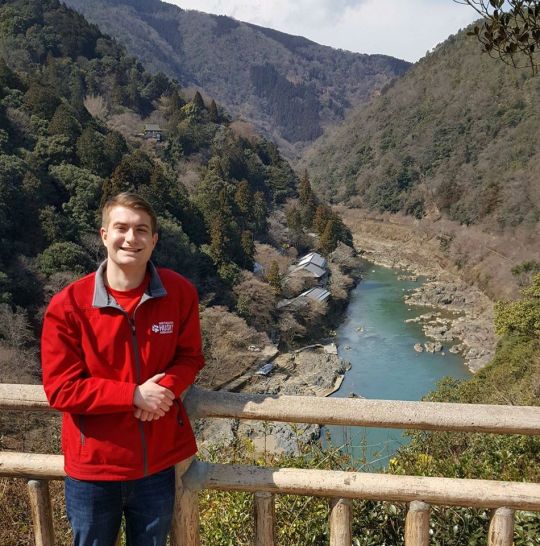
My first co-op position was as a Disposables Engineering Co-op at NxStage Medical, the first company to make it possible for hemodialysis patients to complete their treatments at home, rather than needing to visit a dialysis center several times per week. I was responsible for testing and evaluating the disposable parts of the system, such as needles and blood circuits, making it possible for patients to use this groundbreaking technology. I changed things up for my second co-op, working at a military and aerospace company called Amphenol PCD. I was an Engineering Co-op, and the most rewarding part of working on a small team within the company was that I was able to do all of the same tasks as the senior engineers, working directly with our customers to specify and design cable assemblies for a wide variety of applications. My third co-op was as an Engineering Co-op at a company called Coravin, which produces a device that allows the user to pour a glass of wine without removing the cork from the bottle! Working at a quickly growing startup, I helped with a wide variety of tasks throughout the company, helping to prepare for the launch of the Coravin Model One, a new, lower cost version of the company’s product.
Aside from co-op, being able to get involved as a student volunteer really helped my shape my Northeastern experience. During the summer after my second year, I was given the opportunity to travel with a group of students from the College of Engineering to Panama, working with an organization called Sustainable Harvest International to promote sustainable farming practices among farming families in Central America. Throughout the week in Panama, we worked to help build a water storage tank at the village school, construct aggregate water filters and fuel-efficient cooking stoves and families’ homes, and plant trees on a mountainside. At the end of the week, we were given the opportunity to meet up with a NU student on co-op with the Panama Canal Authority, receiving a tour of the Canal expansion, the world’s largest construction site! The following summer, I was given the honor to be the student leader for the trip, allowing me to share my previous experience with other students. That year, we traveled with SHI to Belize, constructing water tanks, earthworm-enhanced composting bins, and chicken coops, along with helping a 17 year old farmer to plant 200 coconut trees!
Through the co-op and volunteer opportunities I have been able to participate in thanks to NU, I am now ready to determine what I want to do with my career. I’m currently in the process of looking for a full-time job in either the aerospace or renewable energy fields, and I’m hoping that my job will bring me to a new adventure in either Seattle, WA, Portland, OR, or Denver, CO. I’m very grateful to Northeastern for the chance to experience three different co-ops, work with people half way across the globe, and share my experience with future Huskies as a Husky Ambassador.
#nuhusky#northeastern#spotlightseries#guestblog#boston#bostonblogger#world#experiences#springbreak#coop#workxp
1 note
·
View note
Video
youtube
New WILHELM´s Song
When There´s a Will There´s a Wind (Feat. Ana Fuertes BELIZE)
A song where I claimthe existence of a sun beyond the clouds. I urge the awakening of the free creature that sleeps inside us, and reclaims the capacity to create a story of our own lives, far from fear, “duty” and disappointment. Composted in the summer of 2015 during a introspective trip to Denmark where I had the opportunity to observe the meaning of life fleetingly through the beauty of two free seals. Produced during 2016 in my studios for WTAWTAW with the collaboration of Ana Fuertes (BELIZE), and a broad range of influences from retrosynthwave to Korn (yes, Korn). But haven't WILHELM separated? Yes. WILHELM is not a band, WILHELM are sounds and messages, they are also my studio, seals, wind and I will follow it as it strikes me. FOREVER LOVE Guille
2 notes
·
View notes
Text
Chocolate and Mezcal Pairing in Oaxaca, Mexico: Some Thoughts on Product Commonalities, Differences
She's a tease. There's no doubt about it. "No, not yet, you have to wait until I'm done first, please," she entreats mezcal artisanal. While the foreplay is interesting, and sensuous to the extreme, I want to jump right in - and get at the three young mezcals, with 18 chocolates set up in front of them.
The evening was billed a mezcal and chocolate pairing event, or a maridaje in local parlance, held at Restaurante La Olla in downtown Oaxaca. It was hosted by owners Chef Pilar Cabrera and Ing. Luis Espinoza, and their special guest, chef/chocolatier Arcelia Gallardo. Mezcal brands Koch and Vago were featured.
Of course Chef Gallardo simply wanted us to hold off delving into her enticing chocolates alluringly set in front of us, with water at the ready and three mezcals in the wait. The idea was to direct us when to sample what, in the course of her discourse.
This was more than a mezcal and chocolate combining encounter. It was a treatise on the history of cacao, a lesson on the production of chocolate, and a discussion of its different formulations based on country / continent of origin. In addition, of course, there was the main focus, learning an appreciation of different mezcals as paired with a variety of chocolates. Each chocolate had been hand-crafted that very day by Chef Gallardo using Oaxacan ingredients she had earlier sourced with the assistance of Chef Pilar.
"I came to Oaxaca principally to learn about the region's unique flavors and ingredients, with a view to experimenting with how I could incorporate what I discovered into my chocolate," she explained.
Yes, the packed house learned about chocolate's Mesoamerican origins, the differences between South American, African and American cacao concoctions, what exactly white chocolate is, why chocolate melts in your mouth (and in fact in your hands), and tasting notes relative to each sample devoured. But for me, a mezcal aficionado and researcher for in excess of two decades, what struck home most were the elements in common between and contrasted with cacao and chocolate on the one hand, and the iconic Mexican spirit on the other.
Naturally I was interested in everything Chef Gallardo had to say, given that it was all new to me; and who doesn't have an interest in the wherefores and whys of chocolate? But I continually found myself relating what I was being coached about cacao and chocolate, to mezcal as well as pulque.
The Historical Record
In tracing the use of cacao to the Olmec civilization some 3,000 years ago, our grand maestra noted that residue of the cacao compound theobromine has been found in pottery vessels, evidencing its earliest consumption in Belize and Guatemala. My interest initially piqued recalling that archaeologists in Mexico have found clay pots with traces of alcohol, leading them to theorize about a pre-Hispanic distillation tradition. Many Mexican spirits thinkers take issue with this latter reasoning, primarily because there have not been codices, pictographs and the like found, detailing distillation as a cultural indicia among indigenous groups. The more accepted thinking is that the Spanish learned distillation from the Moors, and subsequently brought this knowledge to The New World, no earlier than in the first quarter of the 16th century.
With her powerpoint presentation Chef Gallardo showed us photographs of various paintings and clay containers, representing a Mayan god embracing a bowl containing cacao; a squirrel holding a pod; cacao vessels in ancient tombs; Aztec glyphs and notations in scriptures; a goddess of cacao; and more. The proponents of pre-Hispanic distillation, by contrast, have not been able to tie together the slight evidence of alcohol, with neither drawings nor stone or clay representations of anything beyond fermentation. Where to date they have failed, the chocolate historians have convincingly succeeded.
Modern Day Manifestations of Commonalities and Contrasts
One of the main positives in common between the production of chocolate and mezcal relates to the concept of bio-diversity and agro-forestry. Chef Gallardo pointed to cacao plantations being suited to multiple crop land use. Cacao can be shaded by allspice and coconut, and cardamom is capable of providing good ground cover. Regarding mezcal production, in between rows of agave and at times growing simply amongst the plants, crops such as alfalfa, garbanzo, corn, beans and squash are frequently found, enabling growers to reap annual rewards while waiting for their principal crop to mature - often eight to ten years after planting, at times much longer.
Chef Gallardo lamented the backbreaking work of cacao growers, and the often paltry wages they are paid, at least relative to the retail prices designer chocolate fetches. Farmers are required to check the trees as often as on a daily basis to ensure infestations do not take hold. Agave, on the other hand, requires very little attention. But the work of those who spend their days in the sun-drenched fields and slopes cutting the plants out of the ground and lifting the resultant piñas onto trucks, is grueling enough.
While the current price per kilo of agave used in mezcal production is upwards of tenfold and in some cases more, compared to what it was only three or four years ago, this fact does not necessarily translate to farmers obtaining an appropriate piece of the pie, given the work they do and market fluctuations. The same holds true for artisanal distillers. The lion's share of campesinos and palenqueros are not enjoying an appreciably better standard of living, as compared to what is happening outside the villages of production. The price of export quality mezcal will continue to rise mezcal. As compared with the vagaries of living for the growers and producers, there will be no peaks and valleys in the financial fortunes of its foreign agents, its importers, and its retailers be they stores, bars or restaurants. In this vein, concerns by some "in the know" regarding the mezcal industry mirror those with a social conscience in the chocolate industry, such as Chef Gallardo.
Chef Gallardo commented briefly on the use of fertilizer for growing cacao, stating that many growers do not even know the term, let alone about the issue of chemical versus organic growth stimulants. My mind raced along to those mezcal producers boasting organic production, and recalling a friend in pulque production telling me that he composts whatever animal feces is available to use as fertilizer for his pulquero agave, but that it really isn't enough to provide a significant change in growth pattern, and that in any event he simply cannot afford chemical fertilizers. Most small scale agave growers are practicing organic production without even considering the marketing aspect of their practice.
But what struck home perhaps the most were other matters relating to regulation and marketing of chocolate production, issues which mirror concerns of some commentators in the mezcal industry. And even if those concerns are not at the fore in chocolate chats, then they are certainly on the minds of chocolatiers such as Chef Gallardo.
Two sheets of paper in front of each attendee contained square boxes, with a different chocolate in each, with producer and origin noted: Dandelion from Venezuela and the Dominican Republic; Madécasse and Akesson from Madagascar; and Valrhona from Africa. As the lecture proceeded, we began tasting the chocolates while discerning different appearances, aromas, textures and finally tastes. In the course of an extremely enlightening question and answer session, Chef Gallardo confirmed what I assume most of us had at least considered, that origin is a major determinant of flavor. I asked from what country(ies) the African chocolate we have sampled is derived. She replied:
"There are so many trade secrets in the industry. There is no labeling requirement to disclose country of origin or even the percentage of powder versus cacao butter used in production."
The chocolate from the Dominican Republic has dried cherry tones. "The country taste is clear," Chef Gallardo confirms, then continued, "our Madécasse Madagascar sample contains vanilla."
If producers label chocolate from Madagascar with the country of origin, why do they not label chocolate from other countries in Africa in a similar way, given in particular the extreme diversity in climatic regions and terroir on the continent and the importance of country of origin in determining flavor?
I am less than a novice when it comes to cacao and chocolate. However, no doubt there are ongoing round table discussions and perhaps even cogent and convincing answers to the foregoing question and other matters relating to labeling.
As the evening progressed I proceeded to consider comparisons and contrasts and live issues in the mezcal industry which relate to chocolate regulation.
Labeling of mezcal for export is regulated to a significant extent, although quality, quantity and parameters are often debated. We have denominación de origen, alcohol content and percentage agave used in production all required to be noted. I have personally questioned whether the mezcal industry would be better served with more comprehensive labeling of region where the agave was grown versus fermented versus distilled, and species and subspecies of agave given the plethora of often confusing local variations in terminology. But after having heard what's going on and arguably lacking in chocolate regulation / labeling, I began to think perhaps our own back yard is not doing all that bad.
The Pairings
The first mezcal Koch we sampled was a madrecuixe. Chef Gallardo paired it with a truffle filled with seasonal guava. We then scoffed another truffle with the same mezcal, filled with panela. Our final pairing with Koch madrecuixe was a hard chocolate made with pecan and dried cranberry.
The second Koch mezcal was infused with gusano. For me and for most of the crowd it provided the best-suited mezcal for combining, no doubt due to Chef Gallardo's expertise. I usually do not drink mezcal de gusano. However I found that the semi-hard chocolate topped with a chapulín both complemented and moderated what is often too strong a gusano flavor. The second chocolate entry was made with chiles guajillo and chilhuacle amarillo, the tangy chocolate subtly and correctly overpowering the larva-laden mezcal. The final Koch pairing was with a hard chocolate made with local corn and coconut.
The Vago mezcal was made with corn grown in the same micro-climate where the mezcal was produced, near the tiny Oaxaca hamlet of Candelaria Yegolé. The corn had been infused in a quantity of mezcal espadín, then distilled in a copper alambique topped up with additional espadín a la mezcal de pechuga. The first chocolate was a truffle spiked with rosita de cacao, one of the requisite ingredients used to make tejate, the local, high-nutrition corn and cacao pre-Hispanic drink. The second was an overly salty yet nevertheless complementary milk chocolate made with chipotle and topped with sea salt. The final chocolate entry combined with the Vago mezcal was prepared with pinole.
Mezcal Pairings: Chocolate is But One in the Realm of Combining Partners
Mezcal viewed as a sipping spirit is still in its infancy. And even more so is the perception of it as a beverage worthy of giving consideration for pairing. Some twenty years down the road, perhaps sooner, we might find on our bookshelves a compendium of different types of mezcal best suited for combining with different beverages, desserts and other foodstuffs as well as full meal offerings. Indeed some producers of mezcal añejo have already begun to market by recommending particular qualities of chocolate best combined with their spirit.
Evening sessions have begun to pop up pairing a selection of beers from a particular craft brewery with mezcals from a specific distillery. I envision more professionals' efforts working to find the perfect mix of mezcals with both popular sweets and main courses, especially in those regions of Mexico where mezcal is a locally produced spirit, and in major international centers where the spirit is now in vogue.
Be more conscious of which mezcal you're drinking with what, continue to combine with different chocolates, and like me, consider what's behind the production and marketing of each. In this way you'll support the development of healthier industries, for our benefit and for everyone, in particular those who currently remain near and at the bottom of the production chain.
0 notes
Text
One Minute Tip - How to Add Compost
One Minute Tip – How to Add Compost
How do you amend compost into your planter beds? Ben shares a new discovery from his friend Leonardo (master gardener)!
Ben Gould happened upon his passion for gardening when trying to find the most inexpensive way to travel the world through the WWOOF program in Belize and India. It has since transformed his life in beautiful and unexpected ways. He now educates children on gardening at several…
View On WordPress
#Apartment Therapy#Ben Gould#composting#gardening#how to compost the right way#how to garden#outdoors#tips
0 notes
Text
“Magical Mystery Tour“ in San Pedro, Ambergris Caye, Belize
“Magical Mystery Tour“ in San Pedro, Ambergris Caye, Belize
Since publishing the last edition a load of people (OK, I’m exaggerating , it’s two people ) have contacted me asking how ‘things’ are going in Q Gardens so I thought I should ‘knock out’ an edition to provide an update for those of you (that’s all two of you ) that are interested. For regular readers of this blog I’ll jog your memory as to what Q Gardens looked like when ‘we’ left it. Fairly…
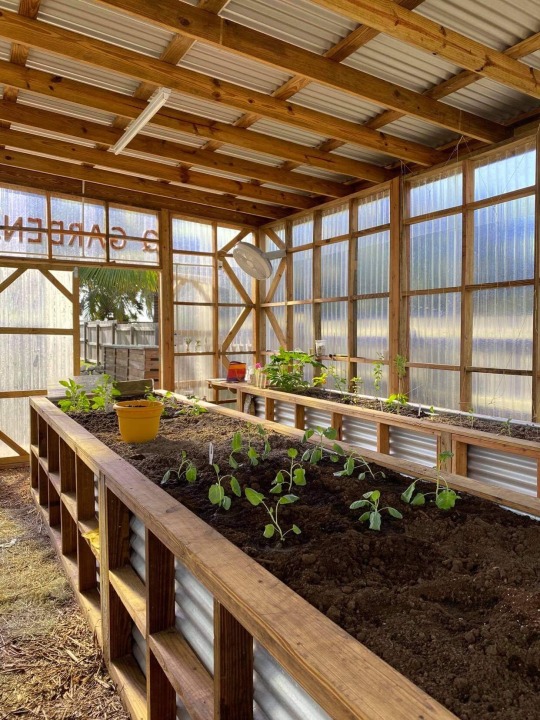
View On WordPress
#abelizehomeforus#Ambergris Caye#Ambergris Caye blog#Belize#Belize blog#Bokashi#building a concrete home in Ambergris Caye#building a concrete home in Belize#building a concrete home on Ambergris Caye#building in Belize#composting in Belize#Estel&039;s Dine By the Sea#expats in Belize#expats in San Pedro#expats on Ambergris Caye#gardening in Belize#hügelkultur#John East#life in Belize#Living in Belize#organic gardening in Belize#organic gardening on Ambergris Caye#organic vegetable gardening in Belize#Qualified Retirement Programme#San Pedro#San Pedro blog#Ziggy#Ziggy Belize#ZiggyBelize
1 note
·
View note
Text
Why You Need To Visit Belize’s Legendary Reef
The Belize Barrier Reef, which boasts world-class snorkeling and some of the most extensive stretches of untouched coral magnificence in the world, was removed from UNESCO’s endangered list last week. The largest reef in the northern hemisphere, it spans 185 miles of Belizean coast, with the Great Blue Hole, an aptly-named sprawling dark blue sinkhole surrounded by a translucent halo of coral reef, its biggest tourist draw. UNESCO has 54 natural wonders on their endangered list; Putting a site on is generally meant to raise awareness of threatening conditions and revitalize preservation efforts. The Belize Barrier Reef landed on UNESCO’s List of World Heritage in Danger in 2009 because of “destruction of mangroves and marine ecosystems, offshore oil extraction, and the development of non-sustainable building projects,” according to UNESCO. Belizeans rely on the reef as their primary source of tourism. For them, the reef’s well-being is not only crucial to the environmental health of their country, but to bringing in revenue. To restore and protect the reef, they’ve put a moratorium on oil exploration and instituted regulations to protect the mangrove shrubs. The measures taken in Belize over the last nine years extend to actions that only tangentially benefit the reef but further highlight Belize’s commitment to sustainability—they’ve even banned single-use plastic utensils and bags.
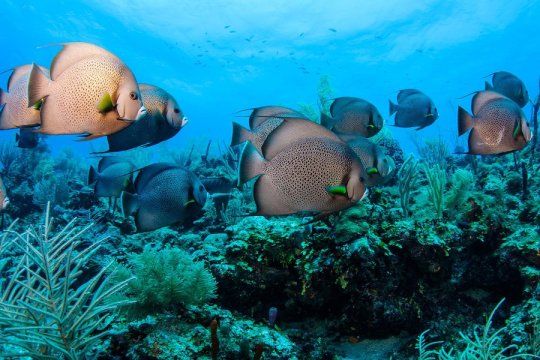
Courtesy Belize Tourism Board Two weeks ago, I was in Belize witnessing these initiatives first hand. And let me just say that the plastics ban is no joke. At Turneffe Island Resort, the bartender told me they had stopped using cocktail umbrellas in drinks, and now only garnish their frozen concoctions with found materials, like flowers or palm leaves. They’re also minimizing waste on the island by composting and are moving from an oil-based generator to solar power, with the goal of making the entire private island solar powered by the end of this year. The snorkeling, diving, and fishing guides cover up enough that they don’t need sunscreen, which is purely to ensure they don’t impact the ecosystem if their limbs graze one of the 500 species of fish or marine life. And deep sea fishing on the Belize Barrier Reef is strictly catch-and-release unless you intend to bring the fish home for dinner. While mainland Belize is home to tropical jungles that are worth exploring, so much of what Belize has to offer is miles off the coast in the three atolls and 400 cayes (or islands) along the Belize Barrier Reef. Some of these cayes are inhabited by luxury resorts, others are completely untouched, and a select few, like Half Moon Caye, are preserved as Natural Monuments by the Audubon Society.
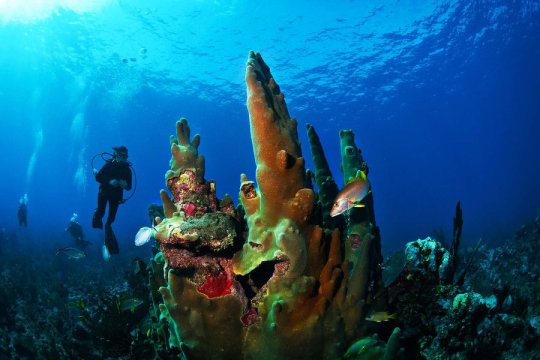
Courtesy Belize Tourism Board Half Moon Caye has the idyllic white-sand beaches you hope to find in the Caribbean, and the water is the shade of turquoise Instagram dreams are made of. The divers told me that even 60 feet underwater, it was so clear that they could see all the way up to the surface. On a day trip to the Great Blue Hole with Turneffe Island Resort, I snorkeled from right off the boat and was immediately surrounded by a school of fish (and a lone, regal sea turtle). I also caught an aerial view of the Great Blue Hole while helicoptering over the Belize Barrier Reef; From above you can see the perfect ring formed naturally in the middle of the Caribbean Sea. Seeing the wonders of Belize up close, it’s abundantly clear why they’re so worth protecting. Read the full article
0 notes
Text
Smooth Chocolator, Charm School and Patric (The BOSS!)
May 25, 2018
Potluck today, at 1:30pm. Bring some food or drink to share. And perhaps some compostable plates? See you then! (Soft close, we will remain open for Momotombo, more info below)

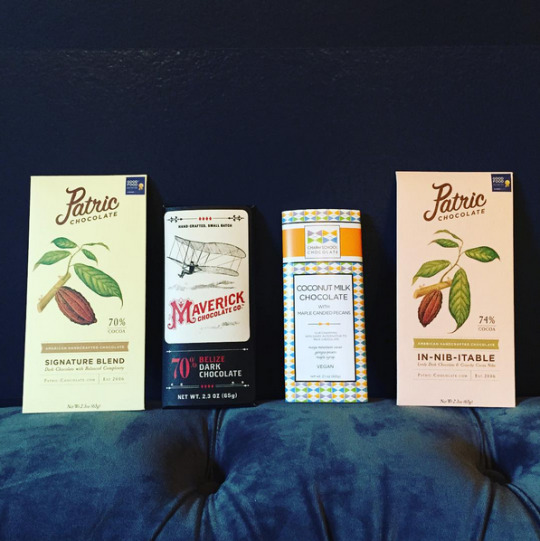
Happy Friday! Bit of a late start today, been learning all about plumbing, caulking, and doing some detective work to figure out the third culprit contributing to a bathtub leak. I *think* I have worked it out and will be good to go, but had to come write to you all to let you know all the special bars we just got in for you before finishing my repair testing. Garage Gathering (Potluck) Before I get started, tomorrow is our potluck! Bring some food or drink to share, or some compostable plates? We will gather right after our Garage hours, at 1:30 pm. We need 20-30 minutes to debrief and wrap up after we close at 1pm, so we will start the nibbling and celebrating around then! It looks quite cool tomorrow (great for chocolate, not so great for us) so wear some warm layers and we'll try to find the sun. Smooth Chocolator Do you remember Yoon Kim from Australia? Her brand is called Smooth Chocolator and we have a few of our favorites back in stock, freshly arrived from Australia. I don't know how it takes less time to get chocolate from Australia then it does to get it from Toronto... In any case, we got Belize, Madagascar, Tanzania, Haiti, Ben Tre (Vietnam), Sierra Nevada (Colombia) and a few Trinidad for those who want to taste a more rare origin. These bars won't last long, the most of each origin we have is 20 bars, so come early! Charm School Chocolate Charm School also sent us what they had in stock right now, so we are re-upped on their plain coconut milk, the same milk with maple candied pecans (swoon) and also their Coconut Milk Mocha bar as well. Patric Chocolate One lovely consequence of our agreeing to take all the chocolate Momotombo could get out of the country (see last week's newsletter) given the impending civil war, is that we decided to keep ordering many of our other favorites too! We are so happy to see the four bars Patric Chocolate made this month: The BOSS (yes! our very own crowdfunded exclusive that is now available to the public), Signature 70%, Black Licorice and the Sweet and Sassy! For those who missed previous emails about the situation in Nicaragua, I will just quickly say that Carlos of Momotombo asked us if we could store all his chocolate, since things are changing day by day in Nicaragua, sales are precipitously down in country, and so instead of risking wasting all his inventory, or having it melt if the power goes or chaos breaks out, he just sent it all our way. I figured you would all step up and help buy, and I agreed to stay open until we manage to sell all the Momotombo he sends us. Fabrica de Chocolate Momotombo For those of you who really want The Chocolate Garage to stay open, this does not mean delay buying Momotombo to keep us open longer ;) please do come buy the Momotombo, because the more you buy, share and gift, the longer Momotombo will be able to stay open in Managua, and that means 12 families and their extended communities will be well and safe. Also, the good news for those who already know Momotombo well, is that a shipment of "fresh chocolates" is right now at the airport in Managua, so it should fly today or tomorrow, which means next Saturday we will have the other special product they are so famous for: fresh chocolates. If you watch our Nicaragua video, Carlos gets into some detail about his desire for cacao to play a more powerful role in Nicaragua and his efforts to create this recipe for making fresh chocolate using only local equipment (comal and corn masa grinder) so that this value add step can be widely accessible to anyone in Nicaragua, and beyond. So, definitely mark you calendars for June 2nd, we will have some of the fresh chocolates available to taste, so you can experience the brownie-fudge kind of texture and see what flavors you like! I have no idea what Carlos is sending, I just gave him a blank check. Well, not literally, that's where you come in, and buy, and then we send him the check. Saturday Tasting Menu Momotombo 72% (mini bar) Smooth Chocolator Haiti 70% Momotombo Milk bar with seeds Patric Chocolate The BOSS SOFT CLOSE For those who have not heard, given the difficult and dire situation in Nicaragua, The Chocolate Garage will stay open to sell Momotombo chocolate. I am kind of rolling my own eyes, because it feels like so much swinging change: "we are closing", um, "no, we are not". "When will you close" you ask? At this point I will say we are taking it month by month, sometimes week by week, and always day by day. So, keep coming, and we will announce when we are going to close. As long as Carlos can send us chocolate and is able to produce chocolate, we will do our best to be here to support the selling of Momotombo, until Managua is calm and back to "normal". I am thinking of perhaps doing a Patreon or Go Fund Me campaign, to ask you all who want us to stick around to contribute a monthly $5, $10, or whatever upper amount you chose to The Chocolate Garage. I am curious how many of you would be willing to put a monthly latte and scone's worth of money towards The Chocolate Garage, to pitch into our operating costs? If you would be willing to charge $10 a month? Shoot me an email, no content needed, just to signal to me that you would be someone willing to have $5 (or $10 or more) charged to your credit card each month, in order to see The Chocolate Garage staff and team stick around and keep being open on Saturdays. Part of me can't believe I am even asking this, but another part of me feels like this whole Nicaragua situation, and some of the interested buyers of The Chocolate Garage have shifted my way of looking at a few things. If any of you have brilliant ideas sparked by my musings, reach out. I am open to anything, and at this time in my life, where most everything is up in the air, and I am being nudged to let go of plans and just stay in the moment, I am not planning further than a few weeks at a time. Talking about plans, I *am* very excited about a new bean to bar maker in Uganda! I tasted their two ingredient 70% dark bar and I was very impressed. This is a very new maker, and I am working on bringing his chocolate into The Chocolate Garage. Excited to see if that can work. So, stay tuned for that, and also next week (fingers crossed) the fresh chocolates buy Momotombo, and I have a few other bars up my sleeves too... one from Brazil, a wonderful maker that a lucky few of you will get to some and visit when we do that origin trip... Enjoy your long weekend! I will be painting, caulking, testing my repairs and getting ready to go on vacation with my kids! Sunita p.s. do you know anyone who needs a dark room to rent in downtown Palo Alto? If yes, email me!
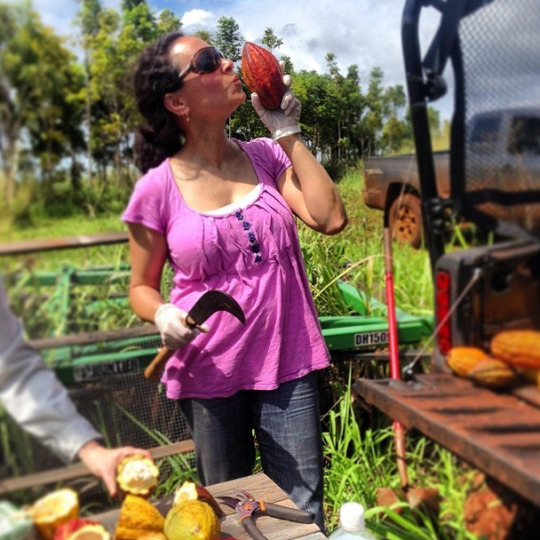
I love cacao, for the potential it holds to transform hearts and minds and bring us a customer driven model for a clean and transparent supply chain. I also like to eat chocolate. Sometimes.
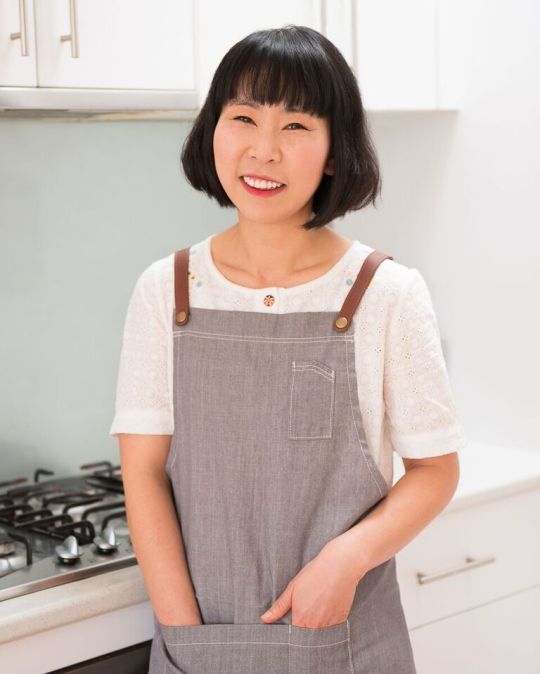
Here is Yoon, The Smooth Chocolator, she just spent time judging cacao in the Solomon Islands and upon her return, boxed up all the bars she had and sent them our way!
#happychocolate#happy chocolate experiences#soft close#Unwrapped podcast#cacao origin trips#momotombo chocolate#nicaragua#Momotombo 72% (mini bar)#Smooth Chocolator Haiti 70%#Momotombo Milk bar with seeds#Patric Chocolate The BOSS
0 notes
Text
Growing and Cooking Tangy Tomatillos
Tomatillos have a tangy, slightly herbal flavor and are most often used in salsas and sauces. A tomatillo can be eaten raw, making for a great salad topper or side. For a few years now, I have been trying to perfect the art of growing them on my Florida homestead. They produced abundantly in the summers in New York when I lived there. But down South, more than a few times, my tomatillo plants have succumbed to whitefly or heat stroke, only to be turned into next year’s compost. Through trial and error, I have recalculated what they like.
Part of the tomato lineage, tomatillos should be grown similarly. Planting them in a raised row gardening setup works well. Place plants three feet apart. Use a trellis or cage to create support. This allows air flow and reduces pests. You can also plant them as if you were growing cherry tomatoes in pots on your deck. Since tomatillos require cross-pollination, grow a few plants near each other. Like tomatoes, when establishing transplants you can bury the seedlings up to two-thirds the plant length to create stronger root systems. To get a jumpstart on the growing season you can start seeds six to eight weeks before the last frost date. Once the weather does not dip below 50 degrees, you can leave the seedlings out to harden.
Coogan enjoying his tomatillo harvest.
Tomatillo plants like a lot of compost, enriched soil, and even moisture. I noticed that when I mulched the plants I encountered less whitefly. This kept the soil moist and required less watering. To prevent whitefly, commercial growers often use reflective mulch which makes the plants difficult for the whitefly to locate. Although they are marketed as full-sun summer crops, down in the South, they did best in early spring with a second crop planted in September. High temperatures and humidity cause the pollen to stick to the side of the flower, lowering pollination. Depending on the variety, plants will fruit in 60 to 85 days. When ripe, a tomatillo feels like an un-ripened tomato. It should be firm and green. Some varieties are the size of a dime, while others are plum-sized. Pick the fruits prior to the husk browning.
Ready to Start Your Own Backyard Flock?
Get tips and tricks for starting your new flock from our chicken experts. Download your FREE guide today! YES! I want this Free Guide »
Tomatillo Salsa
Successful plants will produce around a pound of fruit a season. These yields make for a great crop to add to your fall canning salsa recipes list. After the husks are removed and the skins are washed, the tomatillos do not need to be peeled or seeded. You can flavor this salsa verde recipe with whatever chilies, peppers, or herbs you have available in your garden. Bring the ingredients to a boil and simmer for 20 minutes. Place the hot liquid into pint jars, leaving a half inch from the top. Process in boiling water for 15 minutes.
Salsa Verde
5 cups chopped tomatillos
2 cups chopped, chilies/jalapeños/peppers
4 cups chopped onions
1 cup freshly squeezed lime juice
6 cloves garlic, finely chopped
1 tablespoon ground cumin
Fresh herbs (oregano, basil, cilantro, culantro, parsley)
1 tablespoon salt
1 teaspoon black pepper
Tomatillo salsa tastes great fresh or canned and with meat, vegetables, or corn chips.
Verde tomatillos are the standard fruits for salsas like the famous salsa verde with its dark green color. Courtesy of Baker Creek Heirloom Seeds.
Tomatillo Soup
Using tomatillos as a soup base is a great way to use excess fruits. With peak harvest right before the weather cools, the timing is perfect. When it is about to freeze, pull up the plants and store the fruits on the plant upside down in a cool area. If stored in a root cellar or unheated garage, tomatillos can last a couple of months. On the counter, they last about a week. In the refrigerator, tomatillos can store for up to three weeks. Tomatillos can also be frozen whole or blended, frozen in ice cube trays for later use.
For soup, roast tomatillos and peppers under the broiler until charred. Purée until smooth. As they roast, in a soup pan sauté leeks in oil until softened. Add garlic, herbs, and vegetable broth and bring to a boil and simmer. Combine all ingredients and blend. Serve hot with sour cream, fresh herbs, and warm bread or tortillas.
Roasted Tomatillo Soup
4 medium tomatillos
1 jalapeno or green chile
1/2 cup cilantro or parsley
1 tablespoon olive oil
1 leek, halved lengthwise and sliced
1 clove garlic, minced
4 cups vegetable broth
1 teaspoon cumin
Tomatillo History
Tomatillos are summer annuals originating in central Mexico through Belize, Guatemala, El Salvador, Honduras, Nicaragua, and northern Costa Rica. They have been grown for millennia and were a popular food in Aztec and Mayan societies.
Looking back, 52 million years ago to be precise, tomatillos were tiny. Earlier last year, scientists found two imprints of ancient tomatillos which were the size of a pen cap. Using radiometric dating, the scientists discovered that the nightshade family is at least 12 million years older than originally thought. The fossils show the tomatillo fruit, husk, and stem. Since tomatillos existed at least 52 million years ago, scientists conclude that the grandfather of the tomato and tomatillo must be older than that. Dinosaurs could have been eating salsa verde! But seriously, both tomatillos and dinosaurs could have been alive at the same time.
This 52 million-year-old fossil of Physalis infinemundi is from Laguna del Hunco in Patagonia, Argentina. In this specimen, the former papery and lobed husk is broken at the top to reveal the large, fleshy berry underneath-now turned to coal. Credit: Peter Wilf, Penn State University
This specimen displays the characteristic papery, lobed husk and details of the veins. Credit: Ignacio Escapa, Museo Paleontológico Egidio Feruglio
Today the fruits are used regularly in Mexican and Guatemalan cuisine. Traditionally, tomatillos are combined with chili peppers to make a sauce. Their flavor, a mix of lemon juice and a tomato, cools down the hot flavor of the peppers.
Amarylla tomatillos are great for jams and jellies. Courtesy of Baker Creek Heirloom Seeds.
Purple Coban tomatillo. Courtesy of Baker Creek Heirloom Seeds.
Rio Grande Verde variety. Courtesy of Baker Creek Heirloom Seeds.
Tiny from Coban is a dime-size tomatillo. Courtesy of Baker Creek Heirloom Seeds.
Tomatillo Varieties to Try Amarylla Grows yellow firm fruits which are relatively sweet. Good for jams and jellies in addition to the traditional salsas. 60 days to harvest. Purple Coban Cherry tomato-size fruits ripen from green to purple. Popular in Guatemalan cuisine. 70 days to harvest. Rio Grande Verde This is a determinate plant which grows to medium size and produces apple colored fruits. 85 days to harvest. Tiny from Coban Tiny dime-size fruits are savory compared to the typical tart flavor of tomatillos. Verde The standard large dark green fruit. Bred to produce large yields.
Growing and Cooking Tangy Tomatillos was originally posted by All About Chickens
0 notes
Text
How can you find the best Belize Real Estate for Sale?

Belize is lined with the most amazing beaches as well as private islands with perfect weather and views. The tourism industry in Belize is undergoing a huge metamorphosis. The boom is evident everywhere. So it is hardly surprising to find international property investors making a beeline to invest in Belize real estate for sale. Everyone loves to purchase a real estate near the ocean, but Belize offers great properties that are more inland and include ranches, citrus groves, and raw land for either residential or commercial property. When you invest in real estate that is more inland you will be assured much better waste management and accessibility to utilities. It is a tax-shelter haven where investors do not have to pay any capital gains or inheritance tax. Property taxes are abysmally low at just one percent of the market value of the undeveloped land.
The land has wonderful flora and fauna cover, while the sea is rich with corals and many varieties of fish. Belize is eco-conscious and has made use of all the resources available for practicing sustainable development plans. On Long Caye at Lighthouse Reef, for example, the government has approved the use of the developer's Eco-guidelines for the residents and guests. Housing will have electricity generated by solar power, purified fresh drinking water obtained by reverse osmosis converting sea-water or by harvesting rainwater and storing it in a cistern; while trash is segregated into compostable and recyclable materials. The spurt of growth and activity in the Belize Real Estate segment has prompted the government to take up environmental conservation as a topmost priority. Belize is promoting community living in the country. This gives ideal infrastructure and facilities for smaller developments. To realize this concept Eco-Holdings Limited is offering properties on Long Caye at Lighthouse Reef, which allows for ownership of an eco-friendly house, here in Belize on ones of its most beautiful islands. Community living makes properties affordable to suit all kinds of pockets.
While most people may opt to live by the ocean, properties inland such as ranches, citrus groves, and raw land can provide just as good a location to live or to start a small business. Also, inland properties assure better waste management and accessibility to utilities. (Keep in mind, that energy costs are much higher in Belize because of more primitive infrastructure and because basic resources in Belize are less efficient than first-world countries.) There are several online websites which are providing Belize Real Estate for Sale. Friendlywatersbelize.com also provides these properties at an affordable price.
0 notes
Photo

New Post has been published on http://fitnessandhealthpros.com/beauty/how-to-nail-eco-glam-carbon-neutral-travel-that-leo-dicaprio-would-approve/
How to Nail Eco-Glam, Carbon-Neutral Travel That Leo DiCaprio Would Approve
The travel bug bit me relatively late in life. I used to think traveling was just *okay* until my first trip to Paris in 2014–and since then, I’ve realized that while I am still definitely a homebody, there are places you’ll visit for the first time and feel like you’ve come home.
Right now, I’m in full travel planning mode for my upcoming trip to Amsterdam and Norway to celebrate a big milestone–my 30th birthday! But this time around, I have something else in mind, in addition to booking accommodations and researching sights and restaurants: how to make my trip eco-friendly, and carbon-neutral if that’s possible.
This is nothing new, per se. An astonishing 6 billion “eco-tourists” travel the world every year; eco-tourism is a big business. Lately, a lot of outrageously glamorous eco-resorts have popped up in the most secluded places in the world, presumably running on raindrops and sunshine alone.
For example, months ago I read about Leo DiCaprio’s own birthday trip to Tetiaroa, a private island in French Polynesia. Its website explains in a calm and ethereal manner how the resort is all LEED certified, carbon-neutral, and run in a way that respects the island’s people, flora, fauna, traditions, earth, sky, and the moon. Seriously, nothing was left out of its respect, and I was kind of turned on. But I googled the island and discovered how far away it is from everything–if your two closest neighbors are New Zealand and Peru, you know you’re in the middle of nowhere. You have to take a private plane there–which means a ton of fuel burned just for Leo and the gang.
Got $ 5,000 to burn? You could shower like Leo in this breathtaking bathroom! (Oh that’s $ 5,000 a night, mind).
…But it’ll be worth it when you can have a view like *this*!
This brings us to the question of eco-friendly travel. It doesn’t take a rocket scientist to know that environmentally conscious traveling is more than just a matter of choosing a green hotel/resort (although don’t let that discourage you from going to one!). You have to look at the whole impact of your travel. I turned to Irina Vishnevskaya, the founder and CEO of Alle Travel, for advice on how to see the world without leaving a mark on the Earth (or your conscience).
1. Think South of the border: – “Costa Rica is historically the leader as far as eco-friendly destinations go. The country plans to go completely carbon-neutral by 2021, and they are well on their way already, with officials saying the country is now at 81% of their goal,” Irina points out. It’s also a nature lover’s paradise with gorgeous and varied ecosystems and a ton of fresh fruits and veggies. (Here’s our coverage of vegan traveling in Costa Rica.)
-“Belize is also starting to be a leader in environmentally conscientious and sustainable tourism, and they’ve committed to the 10-island challenge, with the goal of eventually becoming 100% reliable on renewable energy.” 10 Island Challenge is an initiative begun by Carbon War Room, a nonprofit dedicated to fighting climate change. (As an aside, I fully approve of the name “war room”–that war is totally Peaceful Dumpling-approved).
Coincidentally, Leo DiCaprio is also investing in a new eco resort called Blackadore Caye in Belize that seeks to protect and preserve its unique ecosystem, that’s set to open in 2018. It’s supposed to allocate 1/2 of the space as a wildlife preserve, use 100% renewable energy, and serve as a model of sustainability. (I know I sounded a wee critical of Leo earlier, but I think his heart is basically pure, come on).
-“Uruguay is leading the way as far as renewable energy (94.5% of its electricity), and the country was named as a Green Energy Leader by the World Wildlife Fund.”
– Irina notes that for US travelers, these destinations are also relatively close, meaning that the carbon footprint of your flight will be less than other places in the world. This is a good rule of thumb for travelers anywhere in the world–think, is this in my hemisphere? If you have to take 3 planes over 16 hours, it’s going to leave some serious environmental impact.
2. Not just where, but *how* you travel matters.
– Eat Local: “One of the best things you can do when traveling is to eat food that is as local as possible–everything that needs to be imported to suit your foreign palate leaves a carbon footprint. And this applies to drinking, too–please don’t order French wine at a restaurant in Costa Rica,” recommends Irina.
Eat like a local.
Say No to Pools: Ever look at the pictures of those infinity pools right next to the beach and wonder, “Is that really necessary?” Your instincts would be correct–pools come with a huge energy and water wastage. So choose a hotel without one and enjoy the sea or ocean wherever you are–just like nature intended!
So much better than a pool.
– Respect wildlife: “Sadly, animals are often abused to please tourists in search of new Facebook profile pictures. Please don’t ride an elephant. Ever. There’s no “pain-free” way to do so; if you want to hang out with elephants, choose instead an elephant sanctuary (like this one). Taking pictures hanging out with a tiger is a big no-no (they are drugged) and same goes for swimming with dolphins,” says Irina.
– Blue Flag beaches: If you’re looking for sun and sand, go to Blue Flag Beaches. Not only are these often cleaner and more well-maintained, they pass stringent standards for water quality and safety, as well as general environmental management criteria.
– Green Key Hotels: This is a hotel program that aims to reduce utility consumption, waste, and emissions.
– Think sensible: bring your reusable water bottle. This sounds too simple to be listed here, but recently a friend who traveled to Thailand reported being shocked at how many millions (billions?!) of water bottles the tourists generated there–and there were ZERO recycling bins around. No surprise that Thailand is one of 5 countries that dump more plastic into the oceans than the rest of the world combined… Don’t be that tourist who dumps plastic water bottles. It’s terrible anywhere in the world.
3. Offset your carbon footprint before you take off on your trip. While incorporating Irina’s tips, I’m also going to reduce my carbon emissions before leaving. I used a carbon calculator to gauge my trip’s impact (mostly due to the transatlantic flight) and will change my daily habits to earn “points.” Since I’m vegan, ride the subway daily, compost, don’t even do laundry that often (:D), hate bright lights (mmm all about dim), and don’t own an air conditioner, I’m doing pretty good–but not super excellent. My challenge is to reduce plastic waste: although I recycle, any sort of thing that needs to be processed takes water and energy (no brainer). So that means fewer delicious pre-packaged beverages for me! Actually, a sort of mindfulness about my food and not just eating because it’s fun would be beneficial since food production naturally has a ton of environmental impact. I also plan on not buying new clothes or accessories until my trip, since fashion is the second most polluting industry in the world.
Have you taken a deliberately eco-friendly, carbon-neutral trip?
Related: Here’s How to *Actually* Do Tulum, Mexico Like A Green Traveler
How to Reduce Your Carbon Footprint While Travelling
How To Take A Wildly Enchanting (& Sustainable) Trip To New Orleans
Get more like this–sign up for our newsletter for exclusive inspirational content!
__
Photo: Tetiaroa; Aubrey Gates King; Unsplash
Originally from Portland, Oregon, Juhea now lives in NYC with her Oreo cookie cat, Zeus. When she is not writing, she enjoys running in Central Park, yoga, and teaching Barre classes. Follow Juhea on Instagram @peacefuldumpling, Google+ and Pinterest.
Originally at :Peaceful Dumpling Written By : Juhea Kim
#Approve, #CarbonNeutral, #DiCaprio, #EcoGlam, #Nail, #Travel, #Would #Beauty
0 notes
Video
youtube
New WILHELM´s Song
When There´s a Will There´s a Wind (Feat. Ana Fuertes BELIZE)
A song where I claimthe existence of a sun beyond the clouds. I urge the awakening of the free creature that sleeps inside us, and reclaims the capacity to create a story of our own lives, far from fear, “duty” and disappointment. Composted in the summer of 2015 during a introspective trip to Denmark where I had the opportunity to observe the meaning of life fleetingly through the beauty of two free seals. Produced during 2016 in my studios for WTAWTAW with the collaboration of Ana Fuertes (BELIZE), and a broad range of influences from retrosynthwave to Korn (yes, Korn). But haven't WILHELM separated? Yes. WILHELM is not a band, WILHELM are sounds and messages, they are also my studio, seals, wind and I will follow it as it strikes me. FOREVER LOVE Guille
0 notes